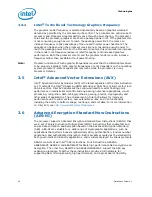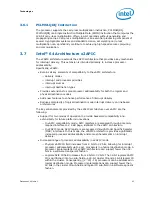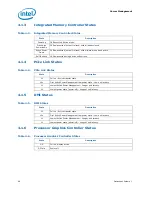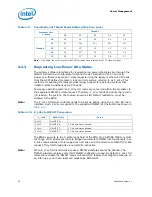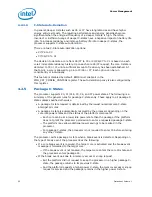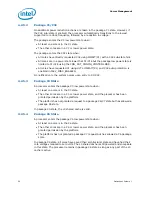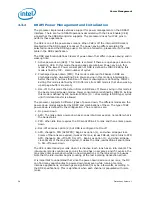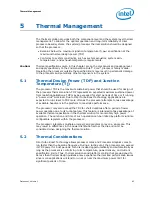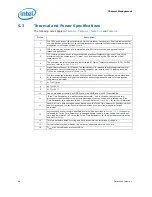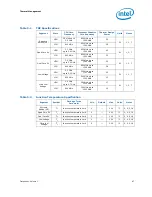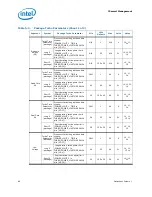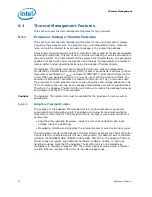
Power Management
56
Datasheet, Volume 1
4.3.2
DRAM Power Management and Initialization
The processor implements extensive support for power management on the SDRAM
interface. There are four SDRAM operations associated with the Clock Enable (CKE)
signals that the SDRAM controller supports. The processor drives four CKE pins to
perform these operations.
The CKE is one of the power-save means. When CKE is off the internal DDR clock is
disabled and the DDR power is reduced. The power-saving differs according the
selected mode and the DDR type used. For more information, please refer to the IDD
table in the DDR specification.
The DDR specification defines 3 levels of power-down that differ in power-saving and in
wakeup time:
1. Active power-down (APD): This mode is entered if there are open pages when de-
asserting CKE. In this mode the open pages are retained. Power-saving in this
mode is the lowest. Power consumption of DDR is defined by IDD3P. Exiting this
mode is fined by tXP – small number of cycles.
2. Precharged power-down (PPD): This mode is entered if all banks in DDR are
precharged when de-asserting CKE. Power-saving in this mode is intermediate –
better than APD, but less than DLL-off. Power consumption is defined by IDD2P1.
Exiting this mode is defined by tXP. Difference from APD mode is that when waking-
up all page-buffers are empty
3. DLL-off: In this mode the data-in DLLs on DDR are off. Power-saving in this mode is
the best among all power-modes. Power consumption is defined by IDD2P1. Exiting
this mode is defined by tXP, but also tXPDLL (10 – 20 according to DDR type) cycles
until first data transfer is allowed.
The processor supports 5 different types of power-down. The different modes are the
power-down modes supported by DDR3 and combinations of these. The type of CKE
power-down is defined by the configuration. The are options are:
1. No power-down
2. APD: The rank enters power-down as soon as idle-timer expires, no matter what is
the bank status
3. PPD: When idle timer expires the MC sends PRE-all to rank and then enters power-
down
4. DLL-off: same as option (2) but DDR is configured to DLL-off
5. APD, change to PPD (APD-PPD): Begins as option (1), and when all page-close
timers of the rank are expired, it wakes the rank, issues PRE-all, and returns to PPD
APD, change to DLL-off (APD_DLLoff) –
Begins as option (1), and when all page-
close timers of the rank are expired, it wakes the rank, issues PRE-all and returns
to DLL-off power-down
The CKE is determined per rank when it is inactive. Each rank has an idle-counter. The
idle-counter starts counting as soon as the rank has no accesses, and if it expires, the
rank may enter power-down while no new transactions to the rank arrive to queues.
Note that the idle-counter begins counting at the last incoming transaction arrival.
It is important to understand that since the power-down decision is per rank, the MC
can find many opportunities to power-down ranks even while running memory
intensive applications, and savings are significant (may be a few watts, according to
the DDR specification). This is significant when each channel is populated with more
ranks.
Содержание 2ND GENERATION CORE PROCESSOR FAMILY DESKTOP - VOLUME 1 01-2011
Страница 10: ...10 Datasheet Volume 1 Revision History Revision Number Description Date 001 Initial Release January 2011 ...
Страница 22: ...Introduction 22 Datasheet Volume 1 ...
Страница 62: ...Power Management 62 Datasheet Volume 1 ...
Страница 86: ...Signal Description 86 Datasheet Volume 1 ...
Страница 106: ...Electrical Specifications 106 Datasheet Volume 1 ...
Страница 172: ...DDR Data Swizzling 172 Datasheet Volume 1 ...

